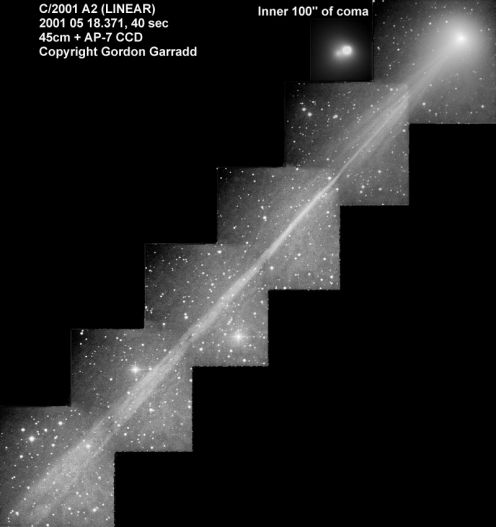
|
Credit:
Credit & Copyright Gordon Garradd, Loomberah NSW Australia
Explanation:
Arcing toward southern skies in late March,
this faint comet LINEAR
-
the one officially
designated C/2001 A2 (LINEAR) -
brightened unexpectedly.
The outburst, apparently due to
the fragmentation of its nucleus,
delighted observers as the comet eventually increased to
naked-eye
brightness.
Comet
LINEAR's tail also grew and in
this mosaic of images from
May 18, astronomer Gordon Garradd has carefully followed the fluorescing
filaments of LINEAR's gas tail stretching 1.5 degrees (the width of
three full moons) along the anti-sunward
direction.
The inset close-up near the top clearly shows two bright condensations
in the
cometary
coma, indicating the presence of a split nucleus.
This comet LINEAR
made its closest approach to the Sun on May 24.
Still showing
off for southern skygazers at about 5th magnitude, it
will become more easily visible for northern observers by late June.
Credit & Copyright Gordon Garradd, Loomberah NSW Australia
|
January February March April May June July August September October November December |
| ||||||||||||||||||||||||||||||||||||||||||||||||
NASA Web Site Statements, Warnings, and Disclaimers
NASA Official: Jay Norris. Specific rights apply.
A service of: LHEA at NASA / GSFC
& Michigan Tech. U.
Based on Astronomy Picture
Of the Day
Publications with keywords: comet - tail - nucleus
Publications with words: comet - tail - nucleus
See also:
- APOD: 2025 November 17 B Comet Lemmons Wandering Tail
- APOD: 2025 September 30 B Comet Lemmon Brightens
- APOD: 2025 September 29 B Two Camera Comets in One Sky
- APOD: 2025 September 26 B A SWAN an ATLAS and Mars
- APOD: 2025 September 18 B Comet C/2025 R2 SWAN
- APOD: 2025 September 16 B New Comet SWAN25B over Mexico
- APOD: 2025 July 7 B Interstellar Comet 3I ATLAS
